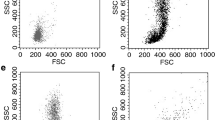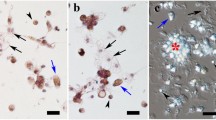Abstract
Molluscan rhogocytes are known to be the only cells able to synthesize hemocyanin that is one of the largest respiratory proteins in nature. However, investigation of rhogocyte cells in vitro is limited due to difficulty in isolating and establishing marine cell culture. The aim of this study was to investigate the nature and distribution of rhogocyte cells of Haliotis laevigata in the mantle tissue with respect to the expression of the two known isoforms of hemocyanin. Rhogocyte cells were identified using immunofluorescence-fluorescence in situ hybridization (IF-FISH) that involved simultaneous staining of localized hemocyanin by a polyclonal antibody while the mRNA was hybridized with FISH probes. The distribution of rhogocyte cells was demonstrated using flow cytometry, followed by cell sorting with fluorescence-activated cell sorter (FACS) and confocal microscope imaging for further characterization. Our results suggested that the mantle tissue is dominated by two distinct populations of rhogocyte cells that synthesize hemocyanin type 1. Observation with confocal microscopy of both populations revealed hemocyanin localization in the periphery of the cell membrane. Cell population with higher antibody signal had irregular and elongated cell morphology with punctate mRNA probe signals. The second population with lower antibody signal had ovoid morphology and wide distribution of mRNA probe signals. We suggest that these populations represent two distinct phases of hemocyanin biosynthesis of a single isoform, which is closely related to Haliotis tuberculata type 1 hemocyanin (HtH1). The knowledge acquired in this study enhances the understanding of the biology of rhogocyte cells and biosynthesis of hemocyanin.








Similar content being viewed by others
Abbreviations
- FACS:
-
Fluorescence-activated cell sorting
- IF:
-
Immunofluorescence
- FISH:
-
Fluorescence in situ hybridization
- mRNA:
-
Messenger ribonucleic acid
- FITC:
-
Fluorescence isothiocyanate
- HtH:
-
Haliotis tuberculata hemocyanin
- HlH:
-
Haliotis laevigata hemocyanin
- KLH:
-
Keyhole limpet hemocyanin
- DAPI:
-
4′,6-Diamidino-2-phenylindole, dihydrochloride
References
Abuzakouk M, Feighery C, O’Farrelly C (1996) Collagenase and dispase enzymes disrupt lymphocyte surface molecules. J Immunol Methods 194:211–216
Adachi K, Hirata T, Nishioka T, Sakaguchi M (2003) Hemocyte components in crustaceans convert hemocyanin into a phenoloxidase-like enzyme. Comp Biochem Physiol Part B Biochem Mol Biol 134:135–141
Albrecht U, Keller H, Gebauer W, Markl J (2001) Rhogocytes (pore cells) as the site of hemocyanin biosynthesis in the marine gastropod Haliotis tuberculata. Cell Tissue Res 304:455–462
Bani G, Delfino G (1974) Ultrastructure of the cells of the boundary layer of small vessels in the digestive gland of the gastropod pulmonate Eobania vermiculata (Müller). Monit Zool Ital - Ital J Zool 8:71–83
Becker MI, Fuentes A, Del Campo M et al (2009) Immunodominant role of CCHA subunit of Concholepas hemocyanin is associated with unique biochemical properties. Int Immunopharmacol 9:330–339
Boer HH, Sminia T (1976) Sieve structure of slit diaphragms of podocytes and pore cells of gastropod molluscs. Cell Tissue Res 170:221–229
Chu C, Rana TM (2006) Translation repression in human cells by microRNA-induced gene silencing requires RCK/p54. PLoS Biol 4:e210
Curtis JE, Hersh EM (1972) The human secondary immune response to keyhole limpet haemocyanin. Clin Exp Immunol 10:171–177
Dallinger R, Chabicovsky M, Hödl E et al (2005) Copper in Helix pomatia (Gastropoda) is regulated by one single cell type: differently responsive metal pools in rhogocytes. Am J Physiol Regul Integr Comp Physiol 289:R1185–R1195
Gebauer W, Harris JR, Geisthardt G, Markl J (1999) Keyhole limpet hemocyanin type 2 (KLH2): detection and immunolocalization of a labile functional unit h. J Struct Biol 128:280–286
Harper E (1980) Collagenases. Annu Rev Biochem 49:1063–1078
Harris JR, Markl J (1999) Keyhole limpet hemocyanin (KLH): a biomedical review. Micron 30:597–623
Harris JR, Markl J (2000) Keyhole limpet hemocyanin: molecular structure of a potent marine immunoactivator. A review. Eur Urol 37(Suppl 3):24–33
Haszprunar G (1996) The molluscan rhogocyte (pore-cell, blasenzelle, cellule nucale), and its significance for ideas on nephridial evolution. J Molluscan Stud 62:185–211
Herscowitz HB, Harold WW, Stavitsky AB (1972) Immunochemical and immunogenic properties of a purified keyhole limpet haemocyanin. Immunology 22:51–61
Herscowitz HB, Diblasio RC, Rosenberg JB (1975) A hemolytic plaque assay for the detection of direct and indirect antibody-forming cells to keyhole limpet hemocyanin. J Immunol Methods 6:331–346
Jones GW, Bowen ID (1979) The fine structural localization of acid phosphatase in pore cells of embryonic and newly hatched Deroceras reticulatum (Pulmonata: Stylommatophora). Cell Tissue Res 265:253–265
Keller H, Lieb B, Altenhein B et al (1999) Abalone (Haliotis tuberculata) hemocyanin type 1 (HtH1). Organization of the =400 kDa subunit, and amino acid sequence of its functional units f, g and h. Eur J Biochem 264:27–38
Lamm DL, DeHaven JI, Riggs DR et al (1993) Keyhole limpet hemocyanin immunotherapy of murine bladder cancer. Urol Res 21:33–37
Lieb B, Dimitrova K, Kang H et al (2006) Red blood with blue-blood ancestry: intriguing structure of a snail hemoglobin. Proc Natl Acad Sci U S A 103:12011–12016
Linn JF, Black P, Derksen K et al (2000) Keyhole limpet haemocyanin in experimental bladder cancer: literature review and own results. Eur Urol 37(Suppl 3):34–40
Manubens A, Salazar F, Haussmann D et al (2010) Concholepas hemocyanin biosynthesis takes place in the hepatopancreas, with hemocytes being involved in its metabolism. Cell Tissue Res 342:423–435
Marigómez I, Soto M, Cajaraville MP et al (2002) Cellular and subcellular distribution of metals in molluscs. Microsc Res Tech 56:358–392
Maroney PA, Yu Y, Nilsen TW (2006) MicroRNAs, mRNAs, and translation. Cold Spring Harb Symp Quant Biol 71:531–535
Martin GG, Bessette T, Martin A et al (2010) Morphology of epithelial cells lining the digestive tract of the giant keyhole limpet, Megathura crenulata (Mollusca; Vetigastropoda). J Morphol 271:1134–1151
Martin AM, Martin GG, Butler R, Goffredi SK (2011) Synthesis of keyhole limpet hemocyanin by the rhogocytes of Megathura crenulata. Invertebr Biol 130:302–312
Masson-Pévet M, Jongsma HJ, De Bruijne J (1976) Collagenase- and trypsin-dissociated heart cells: a comparative ultrastructural study. J Mol Cell Cardiol 8:747–757
Moltedo B, Faunes F, Haussmann D et al (2006) Immunotherapeutic effect of Concholepas hemocyanin in the murine bladder cancer model: evidence for conserved antitumor properties among hemocyanins. J Urol 176:2690–2695
Musselli C, Livingston PO, Ragupathi G (2001) Keyhole limpet hemocyanin conjugate vaccines against cancer: the Memorial Sloan Kettering experience. J Cancer Res Clin Oncol 127(Suppl 2):R20–R26
Skelding JM, Newell PF (1975) On the functions of the pore cells in the connective tissue of terrestrial pulmonate molluscs. Cell Tissue Res 156:381–390
Sminia T (1972) Structure and function of blood and connective tissue cells of the fresh water pulmonate Lymnaea stagnalis studied by electron microscopy and enzyme histochemistry. Z Zellforsch Mikrosk Anat 130:497–526
Sminia T, Boer HH (1973) Haemocyanin production in pore cells of the freshwater snail Lymnaea stagnalis. Z Zellforsch Mikrosk Anat 145:443–445
Steinberg MS, Armstrong PB, Granger RE (1973) On the recovery of adhesiveness by trypsin-dissociated cells. J Membr Biol 13:97–128
Streit K, Jackson D, Degnan BM, Lieb B (2005) Developmental expression of two Haliotis asinina hemocyanin isoforms. Differentiation 73:341–349
Swerdlow RD, Ebert RF, Lee P et al (1996) Keyhole limpet hemocyanin: structural and functional characterization of two different subunits and multimers. Comp Biochem Physiol B Biochem Mol Biol 113:537–548
Van Holde KE, Miller KI (1982) Haemocyanins. Q Rev Biophys 15:1–129
Van Hoof D, Lomas W, Hanley MB, Park E (2014) Simultaneous flow cytometric analysis of IFN-γ and CD4 mRNA and protein expression kinetics in human peripheral blood mononuclear cells during activation. Cytometry A. doi:10.1002/cyto.a.22521
Walter RJ (1986) Clostridial collagenase. A chemoattractant for human neutrophils. Inflammation 10:347–361
Acknowledgments
This study was funded by the Australian Research Council (grant no. LP100100799) and Marine Biotechnology Australia Pty Ltd. We are also thankful to the Malaysian government for the scholarship award to Fareed Sairi, the Flinders University Antibody Facility for antibody production, Centenary Institute for providing access to their flow cytometry facility, and the Australian Centre for Microscopy and Microanalysis (ACMM) for the confocal microscopy imaging.
Author information
Authors and Affiliations
Corresponding author
Rights and permissions
About this article
Cite this article
Sairi, F., Valtchev, P., Gomes, V.G. et al. Distribution and Characterization of Rhogocyte Cell Types in the Mantle Tissue of Haliotis laevigata . Mar Biotechnol 17, 168–179 (2015). https://doi.org/10.1007/s10126-014-9605-9
Received:
Accepted:
Published:
Issue Date:
DOI: https://doi.org/10.1007/s10126-014-9605-9




